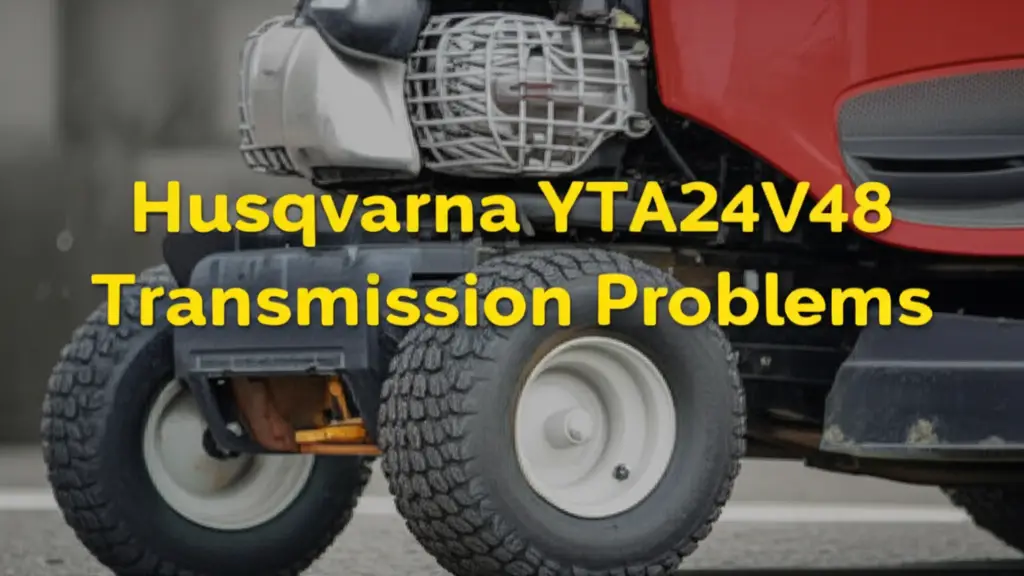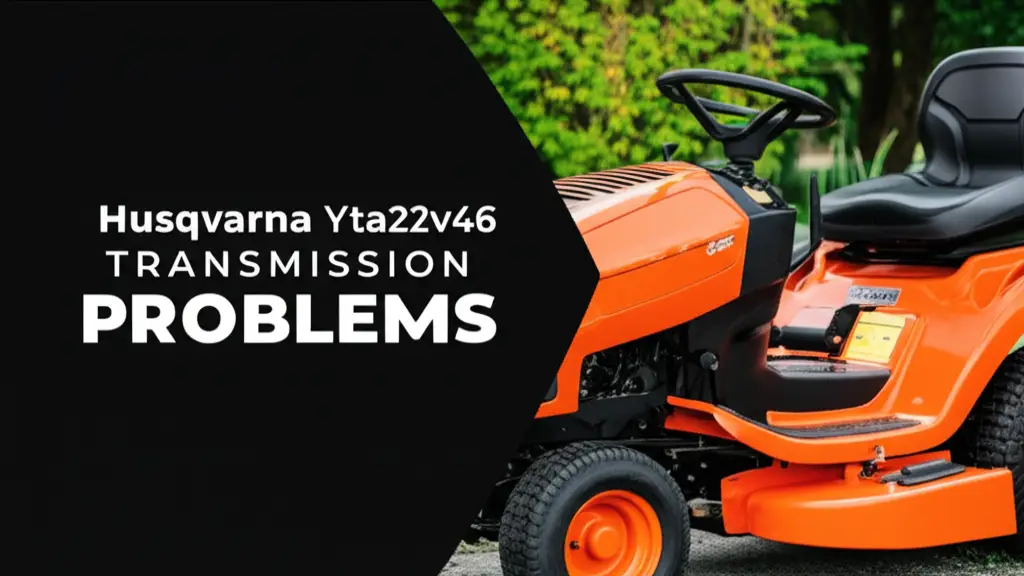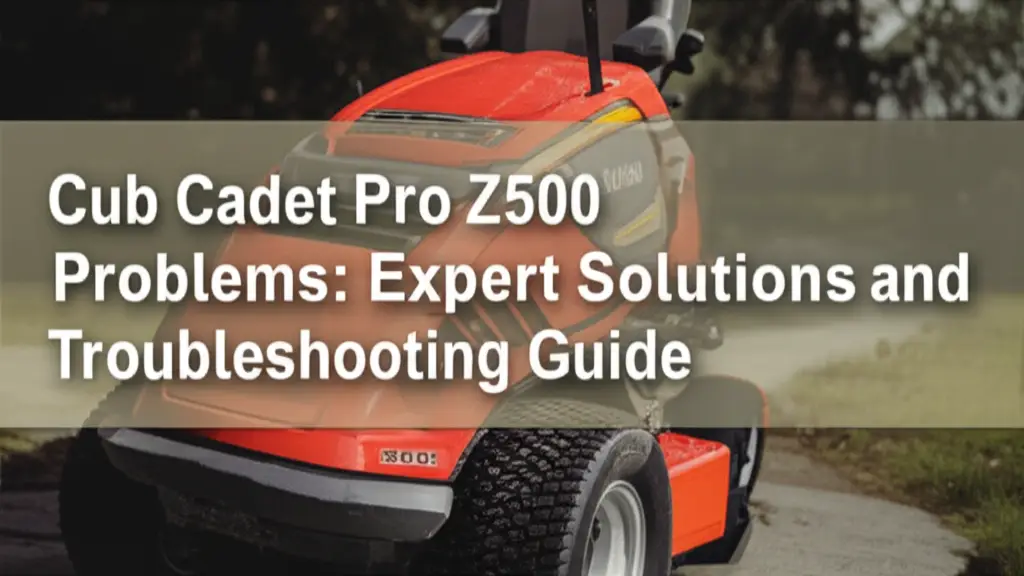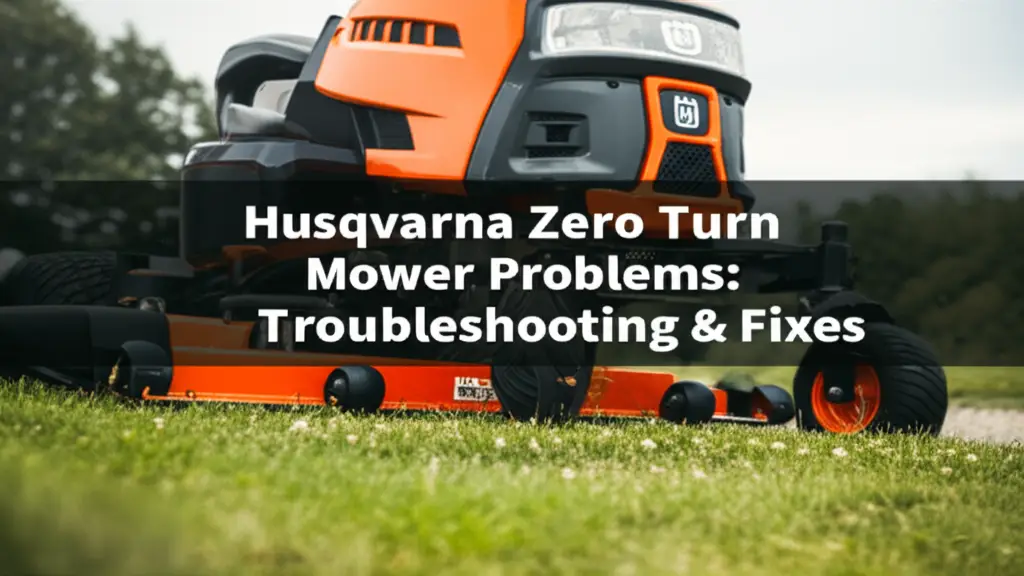· Troubleshooting · 21 min read
Husqvarna Transmission Problems Troubleshooting Tips And Solutions
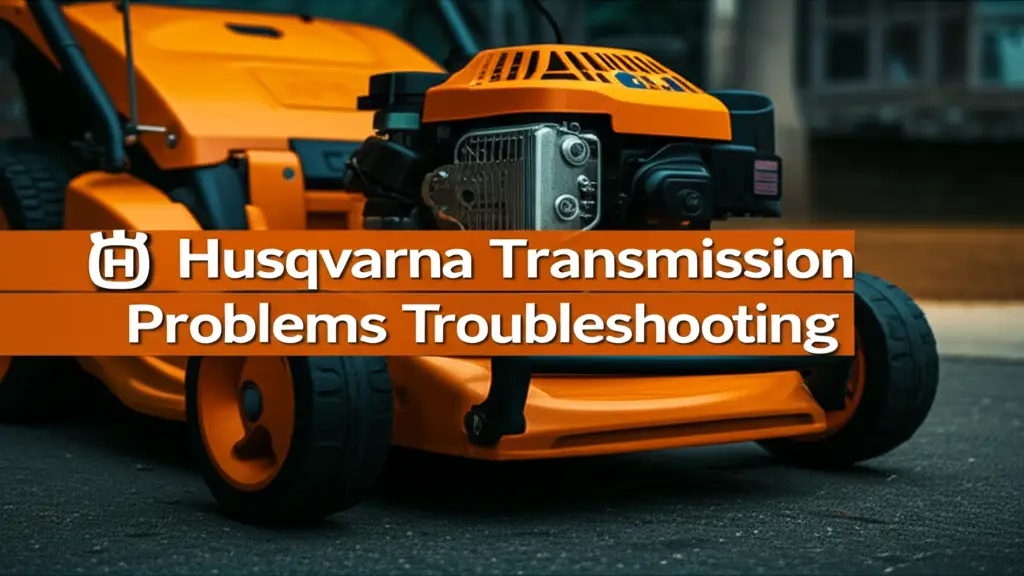
Husqvarna Transmission Troubles? Your Guide to Smooth Operation
Is your Husqvarna riding mower struggling to move, jerking, or refusing to go into gear? Transmission problems can quickly turn a pleasant yard work session into a frustrating ordeal. Fortunately, many Husqvarna transmission issues are DIY-fixable with the right knowledge. This article will walk you through common problems, effective troubleshooting steps, and practical solutions to get your mower back in top working condition. We’ll cover everything from checking fluid levels to identifying potential component failures, ensuring you can tackle the issue with confidence.
Takeaway:
- Regularly check your transmission fluid level.
- Inspect belts for wear and tear.
- Ensure proper linkage adjustment.
- Consider professional help for complex repairs.
Husqvarna Transmission Problems: Expert Troubleshooting & Fixes
Husqvarna lawn mowers are renowned for their robust design and efficient performance, making lawn care a less strenuous task for many homeowners and professionals.
At the core of a mower’s ability to move and operate effectively lies its transmission system, which translates the engine’s power into usable motion for the wheels.
When this vital component experiences issues, it can quickly transform a routine mowing session into a frustrating ordeal, impacting both productivity and the quality of your lawn.
Addressing Husqvarna transmission problems promptly is essential for maintaining your equipment’s longevity and ensuring a smooth, consistent cut.
This comprehensive guide aims to equip Husqvarna owners with the necessary knowledge and step-by-step instructions to accurately diagnose and effectively troubleshoot common transmission issues.
From simple preliminary checks to more intricate repairs, this resource will help individuals restore their mower’s functionality, potentially saving on costly professional service fees.
Key Takeaway Summary
Troubleshooting Husqvarna transmission problems often involves checking for trapped air in hydrostatic systems, inspecting drive belts for wear or misalignment, verifying fluid levels and quality, and examining control linkages.
Many common issues, such as loss of drive or sluggishness, can be resolved with straightforward DIY steps, but professional assistance is recommended for complex internal failures.
Understanding Your Husqvarna Transmission System
To effectively troubleshoot any issue, it is crucial to first understand the system at hand. Husqvarna mowers primarily utilize two types of transmissions: hydrostatic and manual/gear. Each operates differently and is prone to distinct issues.
Hydrostatic vs. Manual: What Powers Your Ride?
Hydrostatic Transmissions
These systems represent a significant advancement in mower technology, offering a seamless and stepless control of speed without the need for traditional gears.
Hydrostatic transmissions operate by using oil under pressure to transmit power. A pump within the transmission pressurizes this fluid, which then drives a hydraulic motor connected to the wheels, enabling smooth acceleration and deceleration.
This type of transmission is prevalent in many modern Husqvarna riding mowers and zero-turn models, contributing to their ease of use and precise maneuverability.
Many of the common transmission complaints and detailed troubleshooting procedures found in support materials specifically address hydrostatic systems, indicating their widespread use and the specific nature of their potential issues, such as cavitation.
Manual/Gear Transmissions
While hydrostatic systems are common, some Husqvarna models, particularly older riding mowers or many walk-behind units, still employ traditional gear-driven transmissions.
These systems rely on a series of gears and a clutch mechanism to transfer power from the engine to the wheels.
Although the provided documentation focuses heavily on hydrostatic issues, it is important to acknowledge that manual transmissions can also experience problems related to belts, linkages, and clutch components.
While specific, in-depth troubleshooting for manual transmissions in riding mowers is less detailed in the available information, general drive belt and linkage issues are applicable to both transmission types.
Recognizing Normal Transmission Performance
A properly functioning transmission provides a smooth, consistent power delivery. The mower should accelerate and decelerate without any jerking, hesitation, or unusual noises.
It should move at the expected speed corresponding to the throttle setting, whether moving forward or in reverse.
Any deviation from this smooth and predictable operation signals a potential transmission problem.
Problem: Mower Won’t Move or Loses Drive
Description
A common and frustrating symptom is when the mower loses its ability to drive, either slowing down significantly or stopping entirely, even while the engine continues to run.
This can manifest as the mower feeling like it is dragging, a noticeable lack of forward or reverse motion, or moving briefly before ceasing movement altogether.
Perhaps one of the most alarming symptoms is when the engine starts and runs perfectly, but the mower remains stationary, refusing to move forward or in reverse.
Causes
For hydrostatic systems, this often points to air trapped in the system (cavitation) or critically low fluid levels.
For any mower type, debris accumulation around the drive wheels or transmission components, or issues with clutch cable or drive belt tension, can also be culprits.
A common oversight is the freewheel control (bypass valve) being in the “freewheeling” or “transport” position, which disengages the transmission to allow the mower to be pushed manually.
Other potential causes include a broken, loose, or dislodged drive belt, extremely low or absent hydraulic fluid in hydrostatic models, disconnected or damaged linkage from the pedal to the transmission, or issues with the PTO (Power Take-Off) clutch or its belt.
Solutions
1. Initial Checks: Parking Brake & Freewheel Control
Ensure the parking brake is fully disengaged. A partially engaged brake can prevent the mower from moving or cause it to operate sluggishly.
Equally important, verify that the freewheel control (also known as the bypass valve) is in the “engaged” or “drive” position, not “freewheeling”.
This control is specifically designed to decouple the hydraulic motor from the pump, allowing the mower to be pushed or towed without resistance or damage to the transmission. If this valve is left open, the hydraulic fluid bypasses the motor, meaning no power is transferred to the wheels, even if the engine is running.
This is a common oversight, particularly after a new mower has been delivered or after servicing, and is a crucial first check for any “no movement” symptom.
2. Clear Debris Buildup
Over time, grass clippings, mud, leaves, and other debris can accumulate around the drive wheels and transmission components.
This buildup can significantly reduce traction or even jam moving parts, leading to a loss of drive. To address this, thoroughly clean out any trash or grass cuttings from inside the dust cover, pinion, and drive wheel gear teeth.
For a more complete cleaning, it may be necessary to remove the hubcaps, locknuts, and washers to take the wheels off.
3. Purging Trapped Air (Cavitation) in Hydrostatic Systems
Understanding Cavitation: Hydrostatic transmissions rely on hydraulic fluid (oil) under pressure to function.
If air enters this fluid, the pump, instead of pressurizing the oil, attempts to pressurize air. This condition is known as cavitation. When cavitation occurs, the pump cannot generate the necessary pressure, leading to a loss of power delivery, causing the mower to become sluggish or lose drive entirely.
Air can enter the system during shipping, after a long period of storage, or if the transmission fluid has been changed.
When to Purge:
This procedure is highly recommended for new mowers before their first use, after they have been stored for an extended period (over two months), or if any loss of drive or sluggish response is experienced.
It is also essential to purge the system if the transmission has been removed for service or replacement.
The consistency and detail of the purging instructions across various Husqvarna-related sources indicate that cavitation is a primary and common issue for hydrostatic transmissions. This procedure is a fundamental, almost mandatory, initial maintenance step.
Detailed Purging Procedure:
This process removes trapped air from the hydraulic system.
- Preparation:
- Park the mower safely on a level, clear surface. Turn off the engine and engage the parking brake.
- Elevate the operator seat.
- Disengage the transmission by placing the freewheel control in the freewheeling/transport position. This typically involves pulling it outward and down for some models, or turning bypass valves for others.
- For zero-turn mowers, it is advisable to place the rear of the mower on jackstands to allow the wheels to spin freely without load.
- Ensure the oil reservoir is properly filled according to your mower’s specifications.
- Cycling the System (Engine Running):
- Sit in the operator’s seat and start the engine.
- Move the throttle control to a slow position.
- With the motion control levers in neutral (N) position, slowly disengage the clutch/brake pedal. Be aware that there may be slight movement of the drive wheels during this step, as air is being removed from the system.
- Push the motion control levers (or the single motion control lever) to the full forward position and hold for five (5) seconds.
- Pull the motion control levers to the full reverse position and hold for five (5) seconds.
- Repeat this forward-reverse procedure a total of three (3) times.
- Post-Cycling & Final Test:
- Move the motion control levers back to the neutral (N) position. Shut off the engine and set the parking brake.
- Check the oil level in the reservoir again and top off if necessary.
- Engage the transmission by placing the freewheel control back into the driving position (the reverse action of disengagement).
- Remove the mower from the jackstands (if used).
- Start the engine. Move the throttle control to half (1/2) speed.
- Slowly disengage the clutch/brake pedal.
- Slowly move the motion control lever forward, allowing the tractor to move approximately five (5) feet. Then, slowly move the motion control lever to the reverse position, allowing the tractor to move approximately five (5) feet backward. Return the motion control lever to the neutral position.
- Repeat this forward-reverse-neutral procedure a total of three (3) times.
- Upon completion of these steps, your mower’s hydrostatic system should be purged and ready for normal operation.
Here is a quick reference table for the hydrostatic purging procedure:
| Step Category | Key Action |
|---|---|
| Preparation | Park on level ground, engine off, brake set. |
| Elevate operator seat (if applicable). | |
| Disengage transmission (freewheel control). | |
| Place rear on jackstands (zero-turn). | |
| Check/fill oil reservoir. | |
| Engine Running Cycle | Sit in seat, start engine, throttle to slow. |
| Disengage clutch/brake pedal (motion levers neutral). | |
| Cycle levers full forward (5s) then full reverse (5s). | |
| Repeat forward-reverse cycle 3 times. | |
| Post-Cycling & Test | Levers neutral, shut off engine, set brake. |
| Check/top off oil. | |
| Engage transmission. | |
| Remove from jackstands. | |
| Start engine, throttle to half speed. | |
| Disengage clutch/brake pedal. | |
| Drive forward ~5ft, reverse ~5ft, return to neutral. | |
| Repeat drive test 3 times. |
4. Inspect Hydraulic Fluid: Level, Quality, and Leaks
The hydraulic fluid is the lifeblood of a hydrostatic transmission. Low or non-existent fluid is a significant cause of transmission problems, potentially leading to transaxle failure.
Regularly check the oil reservoir and add fluid if needed.
The correct oil viscosity is crucial for optimal performance, as ambient temperature directly affects its properties.
Husqvarna specifically recommends a fully synthetic SAE 10W-30 transmission oil, particularly for their AWD (All-Wheel Drive) models, which is designed for extreme temperature stability.
Inspect all hoses and connections for any signs of damage or leaks. Even a small oil leak can drastically decrease internal pressure, leading to movement difficulties and affecting the shifting process.
While some manuals might state that certain transmissions are “sealed for life” and do not require servicing, user experiences indicate that changing the transmission oil can lead to significant improvements in performance.
For mowers with problematic transmissions like the K46 Tufftorq, regular maintenance, including fluid changes, is considered key.
Enthusiasts, even in related fields like motorcycles, often advocate for proactive fluid changes, sometimes as frequently as every 4-10 hours for heavy use, or at least annually, viewing it as “cheap insurance” against costly transmission failures.
This practice suggests that despite manufacturer recommendations, transmission fluid does degrade over time, and proactive changes can prevent problems and extend the lifespan of the unit.
5. Check Cooling Fins (Hydrostatic Transmissions)
Hydrostatic transmissions generate a considerable amount of heat during operation. Pump cooling fins are vital components designed to dissipate this heat.
Regularly clean these cooling fins using a rag, brush, or compressed air, and inspect them for any damage.
Blocked or damaged fins can lead to the transmission overheating, which can cause premature wear and failure of internal components.
6. Inspect Drive Belts: Condition, Tension, and Routing
The drive belt is a common point of failure. Regularly inspect the drive belt for signs of wear, damage, fraying, kinking, or if it has come off the pulley.
A worn or damaged belt is a frequent cause of drive loss or inconsistent movement.
Ensure the drive belt has proper tension. If the belt is too loose, the transmission will not fully engage, leading to slipping or inconsistent movement.
On some models, a turnbuckle located on the underside of the drive control housing can be adjusted to increase tension on the drive cable.
Always verify the belt is correctly routed around all pulleys by referring to your mower’s diagram.
Husqvarna mowers are known for specific issues related to their drive belt systems. For instance, the drive belt idler and tensioner pulleys can become noisy, and belt guides are sometimes prone to breaking off, which can cause the belt to come off when disengaged.
If a high-pitched whine is heard, it might be the drive belt lightly rubbing on the belt guides near the transmission.
This is an acknowledged design consideration by Husqvarna, and a potential fix involves carefully bending the guides out slightly.
This specific issue goes beyond general belt wear, pointing to a targeted area for inspection.
If the drive belt is worn or damaged, it must be replaced. It is highly recommended to use OEM (Original Equipment Manufacturer) belts.
These are typically aramid cord (Kevlar) belts, engineered to resist stretching and provide optimal performance over time.
When acquiring a replacement, rely on the full product number of your mower (e.g., 96045000 01 for a YTA24V48) to ensure you get the correct OEM part, as stickers on the mower can sometimes be incorrect, or different model revisions may use different belts.
7. Examine Clutch System: Engagement and Components
For mowers with a clutch system, proper operation is vital for power transfer. Inspect the clutch cable for any looseness, breakage, fraying, kinking, or damage.
Check the clutch pedal for smooth movement and ensure it returns properly to its original position.
The clutch disc should also be examined for signs of damage or excessive wear, and replaced if necessary.
The PTO (Power Take-Off) clutch is responsible for transferring power from the engine to the transmission and other attachments.
If the PTO switch or clutch itself is faulty, or if the PTO belt is worn, damaged, or misaligned, the mower may not move or the blades may not engage.
Inspect the idler pulley and tension spring associated with the PTO belt to ensure they are functioning correctly and applying the right amount of tension.
For manual transmissions, proper clutch adjustment at both the handlebar and the control arm is crucial to prevent the clutch from dragging.
Additionally, using transmission oil that is too thick can contribute to clutch drag, making it difficult to find neutral or engage gears smoothly.
8. Check Linkage and Control Arms
The various levers and linkages that connect the control arms to the transmission are essential for transmitting your commands to the drive system.
Inspect all these components for any signs of looseness, excessive play, or damage. A loose pivot point at the transaxle or a bent control arm can directly impact the mower’s speed and responsiveness.
Adjusting the arm linking the pedal to the transmission can also help improve speed and overall travel.
9. Inspect Drive Wheels & Axles
Finally, inspect the drive wheels themselves for any damage or excessive wear. Also, check for worn wheel bearings, which can cause friction and impede movement. If necessary, adjust or replace the axle to ensure proper wheel rotation and power transfer.
Problem: Sluggish Performance
Description
A mower that runs but feels sluggish, slow to respond, or struggles to accelerate properly can indicate transmission issues.
Causes
This symptom is frequently associated with old or degraded hydraulic fluids, or the presence of air within the hydrostatic system.
Control linkages that are not allowing for full travel of the transmission’s operating mechanism can also contribute to a perceived lack of power or responsiveness.
Solutions
- Purge Trapped Air (Cavitation): Follow the detailed purging procedure outlined in the “Mower Won’t Move or Loses Drive” section.
- Check and Change Hydraulic Fluid: Ensure fluid levels are correct and consider changing old or overused hydraulic fluids. Refer to your mower’s manual for recommended fluid types and change intervals.
- Inspect and Adjust Linkages: Examine all control linkages for looseness or damage that might prevent full travel of the transmission’s operating mechanism. Adjust as needed to ensure proper responsiveness.
Problem: Jerking, Lurching, or Inconsistent Movement
Description
If the mower moves in a “herky-jerky” fashion, lurches abruptly when starting from a stop, or exhibits repetitive hesitation during operation, the transmission system may be at fault.
Causes
These symptoms often stem from worn dampeners on the control arms, which are designed to smooth out speed changes.
Loose linkages in the control system or air trapped within the hydraulic system can also lead to such inconsistent movement.
Solutions
Inspect and Replace Control Arm Dampeners:
Many zero-turn mowers are equipped with dampeners on their control arms. These components act like small shock absorbers, designed to smooth out speed changes and prevent abrupt movements.
If these dampeners become worn or “shot” (meaning they’ve lost their internal fluid or function), they can cause the mower to exhibit “herky-jerky” motion, lurching, or repetitive hesitation.
A simple test for a worn dampener is to try and move it by hand; if it moves easily with minor pressure, it is likely no longer effective.
This specific wear item can significantly impact the user experience and control precision, and its replacement can resolve frustrating movement issues.
Tighten Loose Linkages:
Inspect all levers and linkages connecting the control arms to the transmission for any signs of looseness or excessive play.
Tighten any loose connections to ensure smooth and consistent power transmission.
Purge Trapped Air (Cavitation):
If your mower has a hydrostatic transmission, perform the purging procedure as detailed in the “Mower Won’t Move or Loses Drive” section, as trapped air can also cause inconsistent movement.
Problem: Unusual Noises from the Transmission Area
Description
Unusual sounds, such as squeaking, rattling, or a high-pitched whining, emanating from the transmission or drive belt area, are clear signs of a problem.
Causes
These noises can be caused by a drive belt rubbing against its guides, worn idler or tensioner pulleys, or general wear within the drive system components.
Specifically, a high-pitched whine might indicate the drive belt lightly rubbing on the belt guides near the transmission, an acknowledged design consideration by Husqvarna.
Solutions
Inspect Drive Belt and Guides:
Check the drive belt for any signs of rubbing against its guides. If a high-pitched whine is present, carefully inspect the belt guides near the transmission.
A potential fix involves carefully bending the guides out slightly to prevent contact.
Examine Idler and Tensioner Pulleys:
Listen for rattling or squeaking noises from the drive belt idler and tensioner pulleys. These components can become noisy when worn.
Replace any worn or damaged pulleys to eliminate the noise and ensure proper belt tension.
General Drive System Inspection:
Conduct a thorough visual inspection of all drive system components for any signs of wear that could lead to unusual noises. Address any worn parts promptly.
When to Seek Professional Help & Understanding Repair Costs
While many Husqvarna transmission problems can be resolved with DIY troubleshooting, there are instances when professional assistance becomes necessary.
Recognizing When DIY Isn’t Enough
It is prudent to seek professional help if:
- Basic troubleshooting steps, including purging the hydrostatic system and inspecting belts and linkages, do not resolve the issue.
- There is a suspicion of internal transmission damage, such as a transaxle failure caused by prolonged operation with critically low fluid levels.
- You feel uncomfortable performing complex mechanical repairs or lack the specialized tools required for certain diagnostics or replacements.
In such cases, contacting your local authorized Husqvarna service center or dealer is highly recommended. They possess the expertise and specialized equipment to diagnose and repair internal transmission issues safely and effectively.
Overview of Transmission Replacement Costs
Understanding the potential cost of repairs can help in deciding whether to pursue a DIY fix, professional service, or even consider replacing the mower.
Full hydrostatic transmission units, often referred to as transaxles, can vary significantly in price.
New units typically range from approximately $710 to over $1,100. Open box or pre-owned units offer a more economical alternative, generally falling between $139 and $595.
Individual transmission parts also come with varying price tags:
- Repair kits for hydrostatic transaxles can range from about $350 to $630.
- Filters, essential for maintaining fluid cleanliness, are typically priced between $15 and $24.
- Replacement belts can cost anywhere from $22 to $80, depending on the specific type and model.
It is important to remember that labor costs for professional replacement will add significantly to these figures.
The wide range of transmission replacement costs underscores the value of early diagnosis and proactive DIY troubleshooting.
A full transmission replacement can be a substantial investment, sometimes approaching the cost of a new entry-level mower, which strongly incentivizes homeowners to attempt the troubleshooting steps outlined in this guide before resorting to more expensive solutions.
Here is a table summarizing the approximate cost ranges for Husqvarna hydrostatic transmission parts:
| Part Type | Approximate Price Range |
|---|---|
| Full New Hydrostatic Unit | $710 - $1,100+ |
| Open Box / Pre-owned Unit | $139 - $595 |
| Hydrostatic Repair Kit | $350 - $630 |
| Hydrostatic Transmission Filter | $15 - $24 |
| Transmission Belt | $22 - $80 |
Preventative Maintenance for Long-Lasting Performance
Proactive maintenance is the most effective strategy for extending the lifespan of your Husqvarna mower’s transmission and preventing common problems.
Consistent care can significantly reduce the likelihood of unexpected breakdowns and costly repairs.
Regular Cleaning:
Keeping your mower clean is paramount. Regularly remove grass clippings, mud, and other debris, especially from the drive wheel area and around transmission components.
For hydrostatic transmissions, regularly cleaning the pump cooling fins is crucial to ensure proper heat dissipation and prevent overheating.
Fluid Checks & Changes:
For hydrostatic transmissions, routinely check the hydraulic fluid levels.
Even if your mower’s manual does not explicitly state a fluid change interval for a “sealed” transmission, consider changing the fluid periodically, particularly if the mower is used heavily.
Oil degrades over time and can cause sluggishness or other performance issues. Always use the correct type and viscosity of fluid, such as Husqvarna’s recommended SAE 10W-30 synthetic transmission oil.
The cost of preventative fluid changes is minimal compared to the expense of major transmission repairs or replacement.
Belt & Linkage Inspection:
Routinely inspect all drive belts for signs of wear, proper tension, and correct routing. Similarly, check all control linkages and dampeners for any looseness, excessive play, or damage. Addressing these minor issues early can prevent them from escalating into more significant transmission problems.
Operator’s Manual:
Always consult your specific mower’s operator’s manual. It contains detailed maintenance schedules and model-specific information that is tailored to your equipment.
Following these guidelines is fundamental to optimal performance and longevity.
Frequently Asked Questions (FAQ)
1. Why is my Husqvarna riding mower losing drive?
Your mower might be losing drive due to debris buildup around the drive wheels, a loose or worn drive belt, a stretched clutch cable, or, for hydrostatic models, air trapped in the transmission fluid (cavitation) or critically low hydraulic fluid levels.
2. How do I purge the hydrostatic transmission on my Husqvarna mower?
To purge, elevate the mower, disengage the transmission via the freewheel control, start the engine at a slow throttle, and cycle the motion control levers fully forward and reverse three times. Then, re-engage the transmission, restart at half speed, and repeat the forward/reverse movement three times.
3. What kind of transmission fluid does a Husqvarna hydrostatic mower use?
Husqvarna typically recommends a fully synthetic SAE 10W-30 transmission oil for its hydrostatic systems, especially for AWD models. This oil is designed for extreme temperature stability across various operating conditions. Always consult your specific model’s manual for the exact fluid specifications.
4. How often should I change the transmission fluid in my Husqvarna?
While some Husqvarna manuals may suggest certain transmissions are “sealed” and maintenance-free, many experts and users recommend changing hydrostatic transmission fluid periodically, especially under heavy use. This can range from every 4-10 hours for aggressive use to annually, as oil degrades over time and can cause sluggishness.
5. My Husqvarna mower engine runs, but it won’t move. What’s wrong?
First, check if the freewheel control (bypass valve) is engaged, which disengages the transmission for pushing or transport.
Other common causes include a broken or dislodged drive belt, disconnected linkage from the pedal, or extremely low hydraulic fluid in hydrostatic models.
6. Why is my Husqvarna mower jerking or moving inconsistently?
Jerking or inconsistent movement often points to worn dampeners on the control arms, which are designed to smooth out speed changes.
Lose control linkages or air trapped in the hydrostatic system (cavitation) can also cause this “herky-jerky” motion.
7. Are Husqvarna YTH series mowers known for plastic transmissions?
No, the common misconception about “plastic transmissions” in Husqvarna YTH series mowers is incorrect.
Plastic transmissions were only present in specific Husqvarna YTA models manufactured between 2010 and 2013. YTH series transmissions are generally more robust.
Final Words
Addressing Husqvarna transmission problems can seem daunting at first, but with the right knowledge and a methodical approach, many common issues are well within the reach of a dedicated individual.
Regular preventative maintenance, including thorough cleaning, diligent fluid checks, and routine belt inspections, stands as your most effective defense against unexpected breakdowns and the high costs of major repairs.
By understanding your mower’s transmission system and recognizing early symptoms, you can proactively ensure your Husqvarna continues to provide reliable service for years to come, keeping your lawn in pristine condition.
If, after exhausting these comprehensive troubleshooting steps, your Husqvarna transmission problems persist, or if you encounter complex internal issues that require specialized attention, do not hesitate to contact a certified Husqvarna service center. For genuine replacement parts, visit the official Husqvarna support website or a trusted parts dealer.

